The Intel Xeon W-3175X Review: 28 Unlocked Cores, $2999
by Ian Cutress on January 30, 2019 9:00 AM ESTGaming: Ashes Classic (DX12)
Seen as the holy child of DirectX12, Ashes of the Singularity (AoTS, or just Ashes) has been the first title to actively go explore as many of the DirectX12 features as it possibly can. Stardock, the developer behind the Nitrous engine which powers the game, has ensured that the real-time strategy title takes advantage of multiple cores and multiple graphics cards, in as many configurations as possible.
As a real-time strategy title, Ashes is all about responsiveness during both wide open shots but also concentrated battles. With DirectX12 at the helm, the ability to implement more draw calls per second allows the engine to work with substantial unit depth and effects that other RTS titles had to rely on combined draw calls to achieve, making some combined unit structures ultimately very rigid.
Stardock clearly understand the importance of an in-game benchmark, ensuring that such a tool was available and capable from day one, especially with all the additional DX12 features used and being able to characterize how they affected the title for the developer was important. The in-game benchmark performs a four minute fixed seed battle environment with a variety of shots, and outputs a vast amount of data to analyze.
For our benchmark, we run Ashes Classic: an older version of the game before the Escalation update. The reason for this is that this is easier to automate, without a splash screen, but still has a strong visual fidelity to test.
| AnandTech CPU Gaming 2019 Game List | ||||||||
| Game | Genre | Release Date | API | IGP | Low | Med | High | |
| Ashes: Classic | RTS | Mar 2016 |
DX12 | 720p Standard |
1080p Standard |
1440p Standard |
4K Standard |
|
Ashes has dropdown options for MSAA, Light Quality, Object Quality, Shading Samples, Shadow Quality, Textures, and separate options for the terrain. There are several presents, from Very Low to Extreme: we run our benchmarks at the above settings, and take the frame-time output for our average and percentile numbers.
[game list table]
All of our benchmark results can also be found in our benchmark engine, Bench.
| Ashes: Classic | IGP | Low | Medium | High |
| Average FPS | 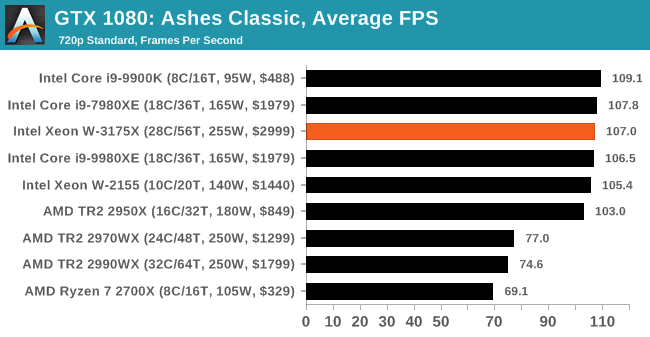 |
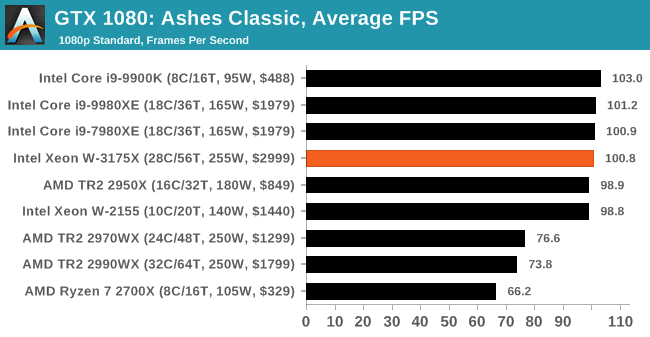 |
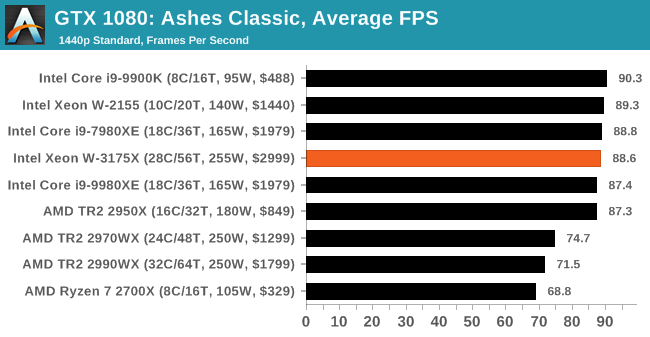 |
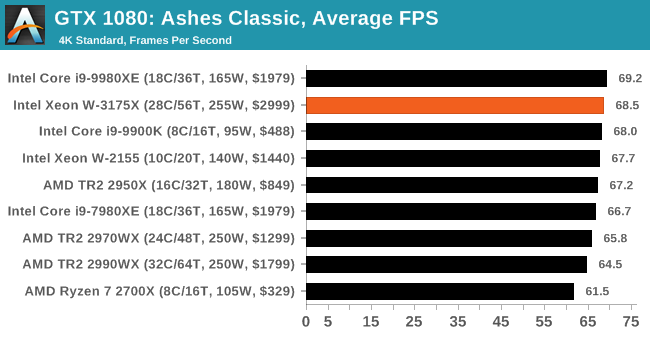 |
| 95th Percentile | 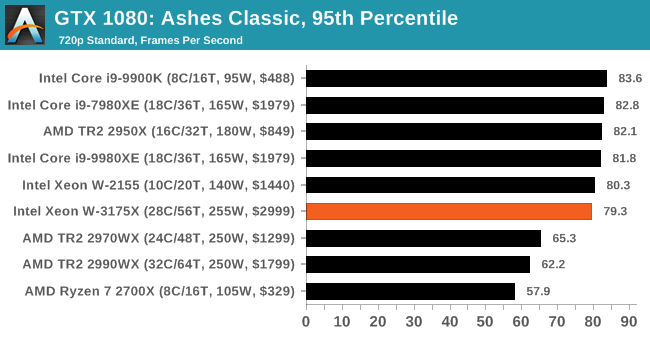 |
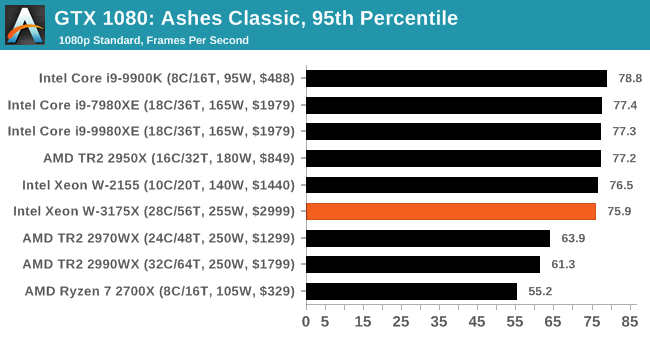 |
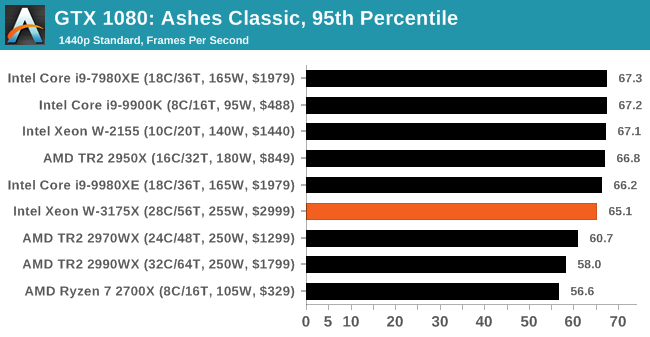 |
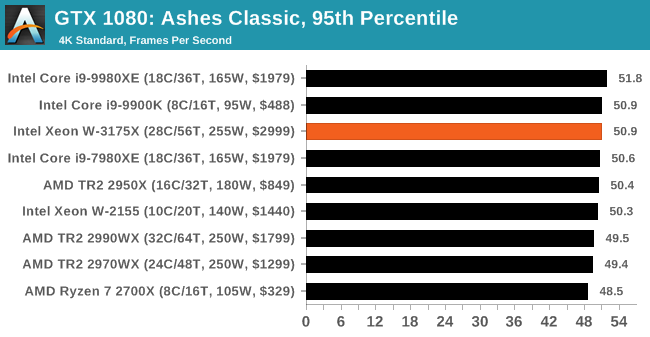 |
.


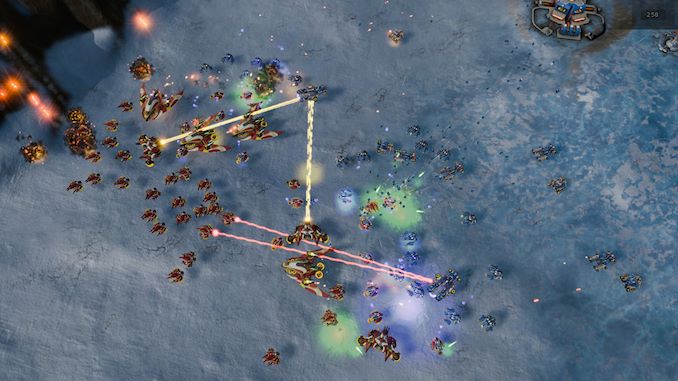









136 Comments
View All Comments
tamalero - Wednesday, January 30, 2019 - link
Aaah yes.. the presenter "forgot" to say it was heavily overclocked..arh2o - Wednesday, January 30, 2019 - link
Hey Ian, nice review. But you guys really need to stop testing games with an ancient GTX 1080 from 1H 2016...it's almost 3 years old now. You're clearly GPU bottle-necked on a bunch of these games you've benchmarked. At least use a RTX 2080, but if you're really insistent on keeping the GTX 1080, bench at 720p with it instead of your IGP. For example:Final Fantasy XV: All your CPUs have FPS between 1-4 frames of difference. Easy to spot GPU bottleneck here.
Shadow of War Low: Ditto, all CPUs bench within the 96-100 FPS range. Also, what's the point of even including the medium and high numbers? It's decimal point differences on the FPS, not even a whole number difference. Clearly GPU bottle-necked here even at 1080p unfortunately.
eddman - Wednesday, January 30, 2019 - link
Xeons don't even have an IGP. That IGP in the tables is simply the name they chose for that settings, which includes 720 resolution, since it represents a probable use case for an IGP.Anyway, you are right about the card. They should've used a faster one, although IMO game benchmarks are pointless for such CPUs.
BushLin - Wednesday, January 30, 2019 - link
I'm glad they're using the same card for years so it can be directly compared to previous benchmarks and we can see how performance scales with cores vs clock speed.Mitch89 - Friday, February 1, 2019 - link
That’s a poor rationale, you wouldn’t pair a top-end CPU with an outdated GPU if you were building a system that needs both CPU and GPU performance.SH3200 - Wednesday, January 30, 2019 - link
For all the jokes its getting doesn't the 7290F actually run at a higher TDP using the same socket? Intel couldn't have just have taken the coolers from the Xeon DAP WSes and used those instead?evernessince - Wednesday, January 30, 2019 - link
How is 3K priced right? You can purchased a 2990WX for half that price and 98% of the performance. $1,500 is a lot of extra money in your wallet.GreenReaper - Thursday, January 31, 2019 - link
Maybe they thought since it was called the 2990WX it cost $2990...tygrus - Wednesday, January 30, 2019 - link
1) A few cases showed the 18core Intel CPU beat their 28core. I assume the benchmark and/or OS is contributing to a reduced performance for the 28 core Intel and the 32 core AMD (TR 2950 beats TR 2990 a few times).2) Do you really want to use 60% more power for <25% increase of performance?
3) This chip is a bit like the 1.13GHz race in terms of such a small release & high cost it should be ignored by most of us as a marketing stunt.
GreenReaper - Thursday, January 31, 2019 - link
Fewer cores may be able to boost faster and have less contention for shared resources such as memory bandwidth. This CPU tends to only win by any significant margin when it whenuse all of its cores. Heck, you have the 2700X up there in many cases.